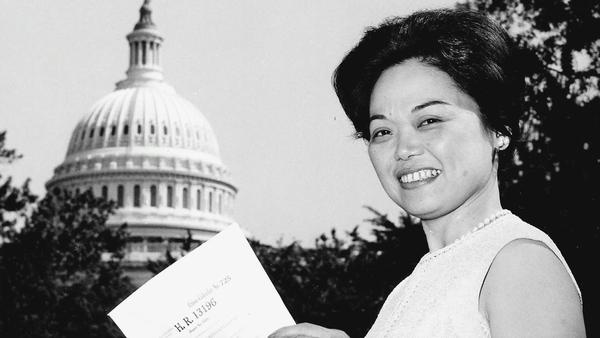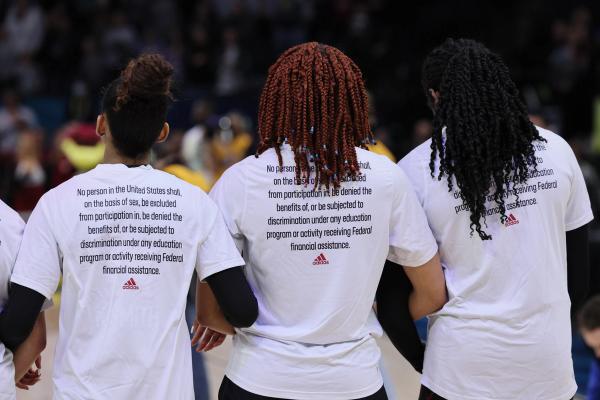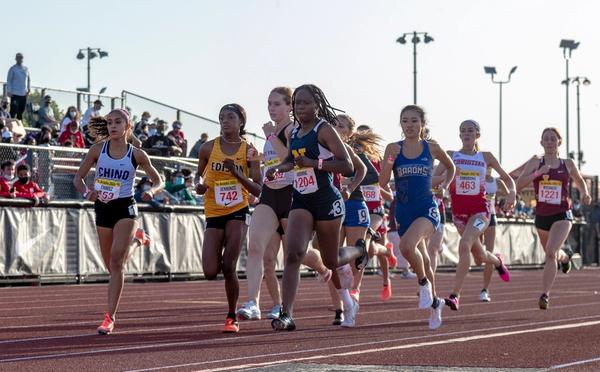How Title IX changed the game

⬅️ The history
The opportunities for women to compete in sports prior to Title IX were severely limited — the NCAA offered no scholarships for women and did not host championships in women’s sports prior to the legislation.
- What’s more, in 1972 (the year Title IX was passed), just 30K women competed in college sports compared to 170K men. Decidedly not it.
Luckily, Representative Patsy T. Mink set out to change that. The first woman of color elected to the U.S. House of Representatives, Mink was the primary sponsor of Title IX, which she authored in response to adversity she faced during her own education.
- Other politicians and activists who championed Title IX include Rep. Edith Green, who oversaw hearings on the legislation, and the aforementioned Dr. Bernice Sandler, who documented and spoke out against gender-based discrimination.
And it’s no surprise that female athletes were also pivotal in passing Title IX. One of those trailblazers? Tennis legend Billie Jean King (BJK). After advocating for gender equity in sports throughout the 1960s and 70s, BJK took to Capitol Hill to testify on behalf of Title IX in 1972. Bow down.
❓ What Title IX does

Title IX is just 37 words — “No person in the United States shall, on the basis of sex, be excluded from participation in, be denied the benefits of, or be subjected to discrimination under any education program or activity receiving Federal financial assistance” — but that text truly changed it all. So, what does the language cover exactly?
- While the word “sports” isn’t included in the provision, women’s sports majorly benefited from Title IX. High school and college programs must now provide equal treatment (training, money, equipment, etc.) and opportunities in women’s and men’s sports.
Title IX protections can also notably extend beyond the playing surface. While the way the law is interpreted shifts with changes in political power, in 2011, the Department of Education (DoED) issued a “Dear Colleague” letter clarifying that the legislation protects all students against sexual harassment and violence.
- Then in 2016, the DoED released another “Dear Colleague” letter, this time reiterating Title IX’s protections for transgender students, outlining that schools must treat students in a manner consistent with their gender identity.
- Unfortunately, those letters were rescinded in the years that followed (the Biden administration is currently working to expand protections again) and trans rights remain under attack on and off the field (more on that later).
💪 The progress

There’ve been plenty of pivotal moments in women’s sports since Title IX was enacted. Let’s take a stroll down memory lane with a look at a few, shall we?
🏀 Overcoming hurdles on the hardwood: Title IX helped to overcome the difference in scholarships for men’s and women’s sports. Basketball player Ann Meyers busted down that wall in 1974 when she became the first woman to receive a four-year athletic scholarship at UCLA.
- Meyers went on to break even more barriers in the years that followed — she posted the first quadruple-double (yes, quadruple) in NCAA Division I history in 1978, then became the first woman to sign an NBA contract in 1979.
🏆 They are the champions: Nine years after Title IX was passed, the NCAA finally established Division I women’s national championships in January 1981 — the first champs in cross country, field hockey, volleyball, swimming, basketball, golf, gymnastics, tennis and softball were crowned that year. Time to queue up Queen.
⚽ ️Kicking out disparities: The world felt the impact of Title IX when FIFA staged the first-ever women’s World Cup in 1991 (over 60 years after the first men’s). But it was well worth the wait — the USWNT hoisted that inaugural trophy, competing with a squad composed of NCAA stars. The rest is history.
🔢 Title IX by the numbers

3.3M: As in 3.3 million, the number of girls who participated in high school sports in 2022, compared to just 295K in 1972. Grow the game, baby.
52: The percentage of women athletes on the 2023-24 list of the top 100 players with name, image and likeness (NIL) deals. Even better, female athletes averaged 3.5 deals compared to male athletes’ average of 2.5.
- NIL transformed the NCAA when it was adopted in June 2021, providing a much-needed opportunity for female athletes to capitalize on their earning potential while still competing at the collegiate level. Cha-ching.
94: Per a 2023 report, the percentage of women C-suite executives who played sports growing up. What’s more, nearly half competed in college sports, too.
10,733: The number of women’s teams that competed at the NCAA level across Divisions I, II and III in 2020-21, compared to just 4,776 in 1981-82.
🔮 The future

Today’s anniversary is cause for celebration, but it’s also a time to recommit to the work that lies ahead. While there’s been plenty of progress, collegiate women athletes are still facing hurdles and unknowns.
Trans athlete discrimination: Eighteen states currently restrict transgender athletes’ participation in collegiate women’s sports. As mentioned, the Biden administration released a Title IX update that would overrule these state bans (but falls short of guaranteeing all trans athletes’ right to play). It’s tied up in the courts, while restrictions for trans athletes just keep coming.*
Lack of enforcement: It’s estimated that more than half of all Division I schools fail to comply with Title IX regulations. The onus is usually on women athletes to spot violations, and complaining to athletic departments might not be enough — some must sue their schools to see issues rectified. Even massive, well-funded and -staffed departments like Oregon often skirt the law with few consequences.
The new frontier of revenue-sharing: With the impending House v. NCAA settlement set to introduce revenue-sharing to college sports, it’s unclear how Title IX regulations will apply to athlete compensation.
- Are female athletes entitled to 50% of all revenue shared, or will the athletes that generate the most revenue (read: football players) earn more? The question will likely be answered in court — hopefully before revenue-sharing begins, which could be as early as the 2025–26 school year.
Enjoying this article? Want more?

Sign up for The GIST and receive the latest sports news straight to your inbox three times a week.

